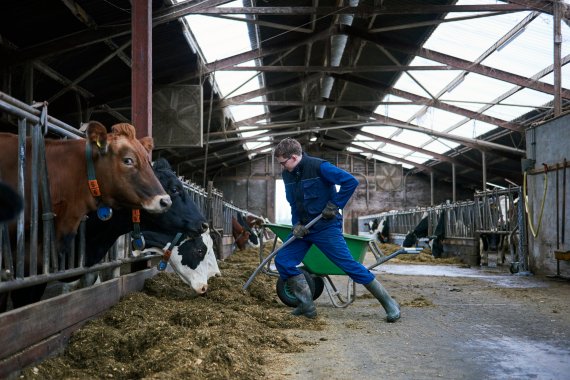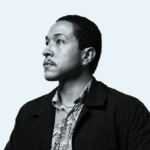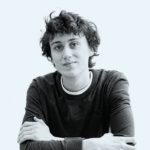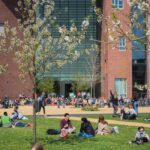Dutch farmers are having a rough time. Their incomes are falling and their public image is indifferent, to put it mildly. But MSc student Jelle Jolink isn’t letting that stop him opting for a career in dairy farming. ‘I was doubtful for a long time, but farmers have an amazing passion for their profession; it’s so great, it’s hard to explain.’
‘The health of the soil is in decline. Everyone’s worried, but not enough is being done about it. As a food producer, I see it as my responsibility to develop a sustainable system that minimizes emissions and protects biodiversity, while still remaining profitable.’ The speaker is Jelle Jolink, a student of Biosystems Engineering in Wageningen on weekdays, who spends his weekends working on De Peppel, a dairy farm in Drempt, Gelderland, with 110 cows.
Jolink manages the manure and the cows’ diet, and helps his father with the day-to-day running of the farm. When his father retires in 10 years’ time, Jelle and his brother Hidde want to take over the family farm. On a grey Saturday in January, he shows me round the farm, in between milking and feeding the cows.
Calves
De Peppel is like an open-air museum, with Jolink as tour guide in blue overalls and rubber boots. The farm itself is 150 years old, he tells me. In the barn adjoining the farmhouse, cows have made way for a workshop. ‘Indoors you can still see a hole where a bomb fell during World War Two; it’s been covered with corrugated iron.’ A few metres away there is a 100-year-old barn: ‘It was once for pigs, but my father got rid of the pigs.’ Now the barn houses calves.
The large barn, with space for 110 cows and the milking plant, was built in instalments. ‘The first section dates back to the 1970s, and after that new sections were added at different times so the herd could grow.’ This is typical of the De Peppel ideology, says Jolink. ‘We don’t grow fast but we do grow steadily.’ Plenty of light comes through the big windows of the barn. Cows chew contentedly on the feed Jolink brings in with the tractor.

Short cycle
From the farmland you can look out over the land, which is part of De Peppel as far as the eye can see. ‘Enough grass and maize to provide our whole herd with roughage,’ says Jolink. ‘We add a small proportion of concentrated feed to that. And now we are also growing fava beans, a variety of soya bean that grows in the Dutch climate, to replace the soya we buy in Brazil.’ This is in line with Jolink’s belief that the shorter the cycle, the better.
‘On the other hand, you can never close the cycle completely. If we were to stop importing artificial fertilizer and concentrates entirely, all the minerals that are in the milk would have to come back to the farm from the sewers. Even if that were possible, you have to remember that a lot of the milk we produce in the Netherlands is for the international market. It goes to China and the rest of the world. So you still have to transport minerals. My aim is to make the cycle as local as possible, but it is never 100 per cent feasible.’
You can only go sustainable if you really set to work at farm level
Sustainable farming
As a prospective farmer and a WUR student, Jolink is actively looking for ways of making operations at De Peppel more sustainable. His search for ways of improving the health of the soil brought him to Thierry Stokkermans, whose company Zip Drill is located in StartHub. Jolink: ‘A lot of research has been done on the advantages of no tillage. The research shows that you can produce just as much without tilling the soil, losing less nitrogen and conserving soil life. And yet most farmers still plough. We’ve been working with Thierry on a four-year trial, growing maize with his no-tillage system. We are monitoring the health of the soil, the yields, the soil life and the organic matter.’
Jolink dreams of an agricultural system that is so sustainable that it could keep going for 1000 years. ‘A system without artificial fertilizer and RoundUp. My father sometimes says, “Tomorrow starts today”. If we want sustainable agriculture in future, we need to start changing things today. And you can only do that by really setting to work at the farm level, not by thinking up lovely systems that farmers don’t adopt.’

Sam the dog
Wherever he goes on the farm, Jolink is followed by a hyperactive puppy called Sam. From the ease with which the WUR student drives the tractor, the pride with which he talks about ‘his’ farm, and the familiar whistle with which he calls Sam to heel, you can see that he is in his element at De Peppel. Nobody watching him now would be surprised to hear he plans to take over the family farm.
Farmers can’t do anything right, but at the end of the day we’ve all got to eat
And yet that couldn’t always be taken for granted. In fact, for a long time it didn’t seem like a realistic option. Jolink suffered from hay fever as a child – not great if you live on a farm. But even when the allergy calmed down, it was not a foregone conclusion that Jolink would become a farmer. ‘It’s hard work, it entails a lot of administration and rules and regulations, and you certainly don’t make a great living out of it. And farmers are not portrayed positively in the news. Either we are producing too much manure, or there are too many cows, or the cows are too crowded together. It is not easy if you only see negative articles about your sector. And some of them are totally wrong. Then farmers can feel as though they are being driven out of business in the Netherlands, because you can’t do anything right. But at the end of the day, we’ve all got to eat.’
To Wageningen
When he finished secondary school, Jolink intended to do a technical degree. ‘I went to have a look at open days, and it was all very nice, but something was missing for me until I looked at the degree in livestock farming at HAS University of Applied Sciences in Den Bosch. Then the penny dropped. I was doubtful for a long time, but farmers have an amazing passion for their profession; it’s so great, it’s hard to explain.’
Jolink finished at HAS when he was 21. ‘My father was 51 at the time. His whole farm was geared to being able to do the daily work, the feeding and milking, on your own. Since my dad wants to go on working until he’s 65, there wasn’t enough work for me. So I could either get a job somewhere else straightaway, or go on studying for another couple of years first.’
That wasn’t a difficult choice: Jolink looked for a Master’s course which would bring together his love of the farming world and technical knowledge. ‘For that you more or less have to go to Wageningen.’ He chose Biosystems Engineering. ‘There I learn that if there is a problem, the first thing you do is to figure out exactly what’s going on. Then you have a look to see if you can solve it with an organic approach.’ He gives the example of ammonia emissions. ‘If manure and urine are not mixed, no ammonia is formed. Cows in the meadow hardly ever poo and pee in the same place, but people put cows in barns, and then the manure and the urine do get mixed together. If you want to solve that problem with organic methods, you are not going to invest air filters and complex floor systems to limit the formation of ammonia. Instead, you’ll look at how to prevent the manure and urine from coming together. Could the cows spend more time outside, for example? Could they be milked out of doors?’
Cows’ toilet
The cows at De Peppel already spend as much time as possible out of doors, and Jolink is now spending his internship looking for a solution to the ammonia problem in the barn: a cows’ toilet. ‘At the rear end of the cow, just above the udder, there is a kind of nerve. If you touch it, the cow pees. We are developing a system in which a cow comes to eat concentrated feed pellets in a stall. Behind the cow is a container for urine, and a mechanism that presses on that nerve so the cow pees. The urine doesn’t end up on the floor but stays separate from the manure. Initial model calculations show an ammonia reduction of at least 50 per cent.’
Jolink’s father, Henk (54) is enthusiastic. ‘In a few years we are due to replace our old barn. If you build a new barn now, you have to build low-emission floors that limit ammonia emissions. That is a very complicated setup with valves and so on, which don’t work well at all in practice. A cows’ toilet is a fundamental principle that works, and you can expand it if you want to expand the farm.’
It can be quite nice to be surrounded by 28 ladies who don’t talk back
Meditative milking
Late afternoon is milking time. Jolink junior herds the cows to the queue, and his father lets the first 28 into the milking shed. One after another, they have their udders cleaned, after which suction cups are clamped onto the nipples and milking can begin.
It is hot and steamy in the milking shed, and the continuous slurping and pumping sounds have a slightly hypnotic effect. Milk pours into the tanks. A nice photo opportunity, because in the end this is what it’s all about, this is what the farmer does it all for. But the photographer has to wait a moment before she can take a picture, because the first group of cows has almost been milked and then the next one is ready. No time to pose now, because it’s ‘ladies first’.
While milking is going on, Jolink ponders his day. ‘It’s nice to be among the cows and see them individually for a moment, and see how they are doing. It never ceases to amaze me that as a farmer, you and your cows can turn grass – something humans can’t do anything with – into milk, which contains nearly all the essential nutrients. Milking itself gives me a peaceful feeling. It can be quite nice to be surrounded by 28 ladies who don’t talk back.’

 Photos: Marije Kuiper
Photos: Marije Kuiper 

